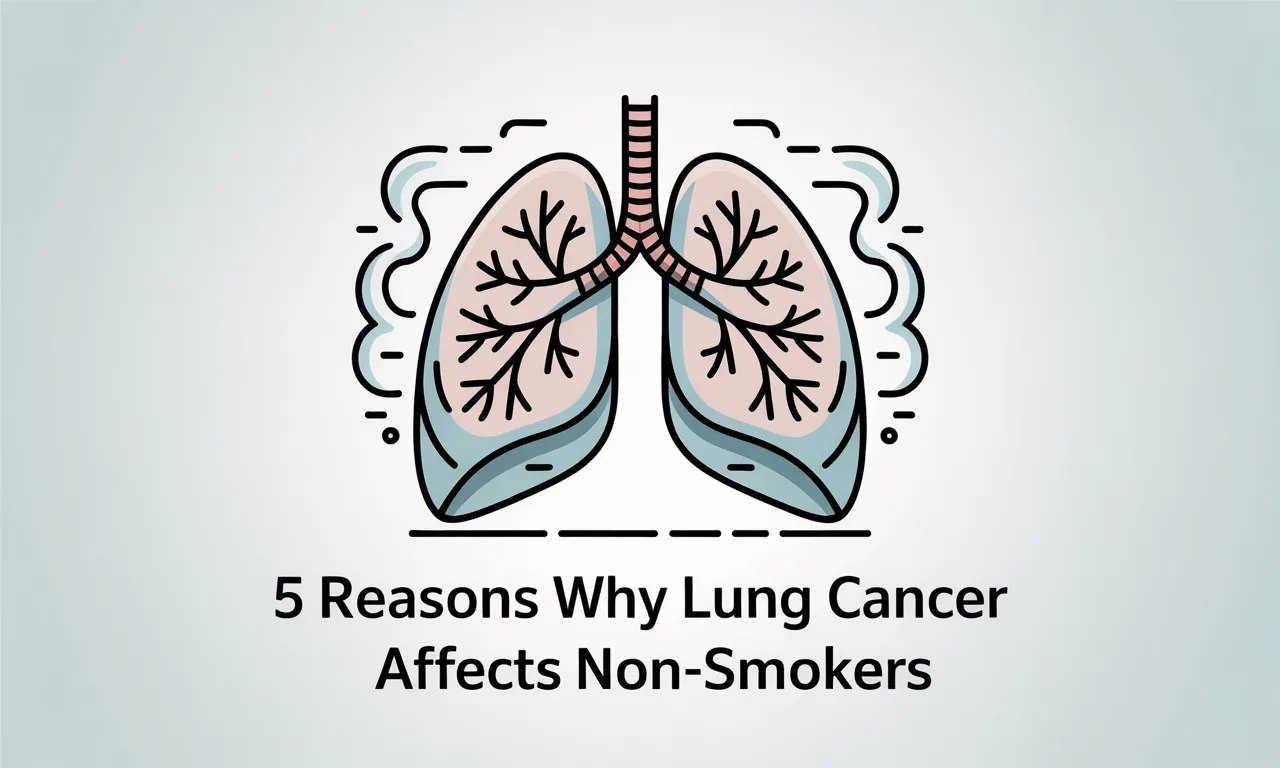When most people think of lung cancer, they immediately associate it with smoking. But here’s a startling truth: a growing number of lung cancer diagnoses occur in people who have never smoked a single cigarette. In fact, according to the World Health Organization (WHO), up to 25% of lung cancer cases worldwide happen in non-smokers.
So what’s behind this trend?
From environmental toxins to genetic predisposition, several hidden factors can trigger lung cancer—even in healthy individuals. In this post, we uncover the top 5 causes of lung cancer in non-smokers and what you can do to reduce your risk.
1. Air Pollution: The Invisible Lung Cancer Risk
Air pollution is now one of the leading causes of lung cancer in non-smokers. Fine particulate matter, especially PM2.5, can penetrate deep into lung tissue, triggering chronic inflammation, DNA mutations, and ultimately cancer.
Long-term exposure to polluted air—especially in major cities or industrial areas—significantly increases your cancer risk, even if you live a healthy lifestyle.
💡 Pro Tip:
Use air purifiers indoors, wear masks on high-pollution days, and monitor local air quality using apps or government websites.
2. Household Pollution from Cooking Fuels
In many parts of the world, especially in rural and low-income areas, families cook using biomass fuels such as wood, coal, kerosene, or animal dung. These fuels release toxic smoke in poorly ventilated kitchens, putting household members—primarily women and children—at risk.
This indoor air pollution causes long-term damage to the lungs and is a proven contributor to lung cancer in non-smokers.
🛠 Action Tip:
Ensure proper kitchen ventilation or transition to cleaner cooking technologies like LPG, electricity, or solar stoves.
3. Secondhand Smoke: A Serious Cancer Threat
Even if you’ve never smoked, being around smokers can be just as harmful. Secondhand smoke contains over 7,000 chemicals, including more than 70 known carcinogens. Long-term exposure—at home, in workplaces, or in public spaces—can lead to the same cellular damage and mutations as direct smoking.
Children, spouses, and coworkers of smokers are especially vulnerable.
🚫 Protect Yourself:
Avoid indoor environments where smoking is allowed and advocate for smoke-free zones in your community.
4. Genetic Mutations and Hereditary Lung Cancer Risk
Some people are born with genetic mutations that predispose them to cancer. For example, EGFR (epidermal growth factor receptor) mutations are commonly found in non-smokers diagnosed with lung cancer—especially women and individuals of Asian descent.
These mutations can cause abnormal cell growth even in the absence of environmental triggers.
🧬 Tip for Early Detection:
If you have a family history of lung cancer or unexplained symptoms, consider genetic testing and consult with an oncologist for personalized screening.
5. Radon Gas Exposure: The Silent Indoor Killer
Radon is a naturally occurring radioactive gas that seeps into homes from the ground, especially through basements or cracks in building foundations. It’s colorless, odorless, and tasteless, making it impossible to detect without proper testing.
Radon is the second leading cause of lung cancer in the U.S., and long-term exposure can be deadly.
🏠 What You Can Do:
Buy a radon detection kit or hire a certified radon mitigation professional to inspect your home, especially if you live in a high-risk area.
Bonus: Other Risk Factors That May Affect Non-Smokers
➤ Pre-existing Lung Conditions
Chronic illnesses like tuberculosis, bronchitis, or interstitial lung disease can leave scar tissue in the lungs. This damaged tissue can later become cancerous.
➤ Delayed Diagnosis in Non-Smokers
Because lung cancer isn’t typically expected in non-smokers, symptoms like cough, fatigue, or chest pain are often misdiagnosed or ignored. This leads to late-stage detection and lowers treatment success.
Protect Yourself Against Lung Cancer—Even if You Don’t Smoke
Non-smokers are not immune to lung cancer. In fact, the disease is often harder to detect in non-smokers because of the false sense of security. The good news? Most of these risk factors can be controlled, monitored, or detected early.
✅ Quick Prevention Checklist:
- ✅ Improve indoor air quality with purifiers and ventilation
- ✅ Avoid exposure to secondhand smoke
- ✅ Test your home for radon
- ✅ Opt for cleaner cooking solutions
- ✅ Consider genetic screening if at risk
Your lungs are your lifeline—take action before symptoms appear.
FAQs About Lung Cancer in Non-Smokers
Q1: Can lung cancer occur without smoking or pollution exposure?
Yes. Genetic mutations and pre-existing lung diseases can trigger cancer even without environmental triggers.
Q2: What are early symptoms of lung cancer in non-smokers?
A persistent cough, unexplained fatigue, shortness of breath, chest pain, or weight loss.
Q3: How do I test for radon in my home?
Radon test kits are available online or at home improvement stores, or you can hire a professional.
🧬 Consider Genetic Testing for Lung Cancer Risk
If you have a family history of cancer or are concerned about your genetic predisposition—especially as a non-smoker—genetic testing can provide critical insights.
One highly recommended option is the Comprehensive Hereditary Cancer Panel Test by DNA Labs India. This test screens for mutations in multiple cancer-related genes, including those linked to lung, breast, ovarian, and colorectal cancers.
Why Consider This Test?
- Detects inherited cancer risks before symptoms appear
- Helps guide early screening and prevention strategies
- Supports personalized treatment plans if cancer is diagnosed
- Especially useful for individuals with no known environmental exposure
🧪 Click here to learn more about the Comprehensive Hereditary Cancer Panel Test →
Taking this step could make all the difference in early detection and prevention.
📌 Did You Know? Recent studies reveal that 1 in 5 lung cancer patients in India are non-smokers, highlighting the need for wider awareness and better screening across all populations.



